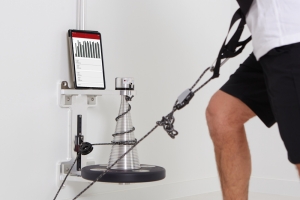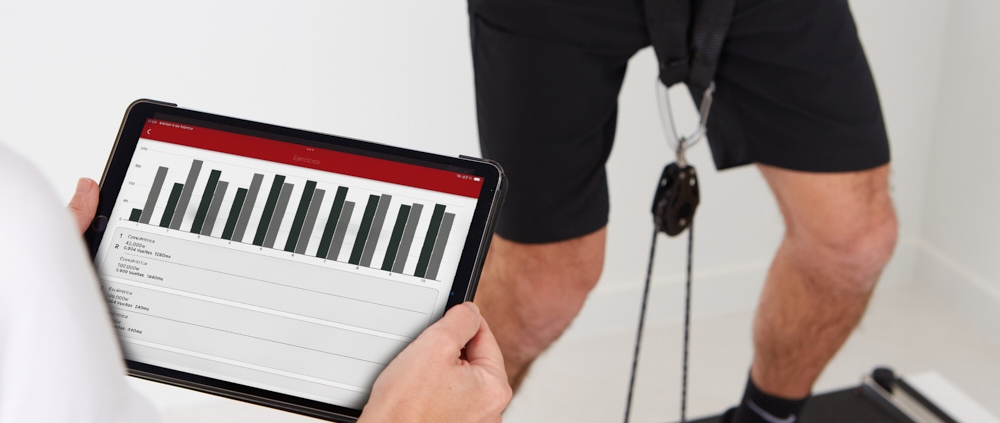HOW TO CALCULATE ENTROPY IN SPORTS PERFORMANCE WITH THE RSP APP
Its application opens up a very interesting way of working to improve sports performance using our isoinertial pulleys, with the help of the
RSP App.
Definition of entropy: A measure of the disorder of a system. The more ordered the system, the lower the entropy. For example: a mass of a substance with molecules regularly ordered forming a crystal has much lower entropy than the same substance as a gas with molecules free and in complete disorder.
With the RSP App, learning how to calculate entropy becomes a practical tool to assess adaptation during trainingTo do this, we observe the evolution of each athlete’s values in a given physical exercise and assess whether he or she is adapting. If adaptation occurs, we can introduce a more complex stimulus; otherwise, we maintain or even reduce complexity.
Keys to calculating entropy in sports performance with the RSP App
When exploring how to calculate entropy, it is essential to monitor how variability in movement reflects adaptation or inefficiency:
-
Monitor Adaptation and Progress in Movement Variability
- Application: Entropy calculation makes it possible to follow the evolution of variability in athletes’ movements over time.
High entropy may indicate excessive variability associated with inefficient or erratic patterns,
while low entropy may reflect rigid movements and lack of motor control. - Practical recommendation: During sports training with the
RSP Conic,
this parameter can be used to adjust loads and techniques in order to maintain an ideal entropy range
that reflects improved adaptability without compromising movement quality.
- Application: Entropy calculation makes it possible to follow the evolution of variability in athletes’ movements over time.
-
Individualise Training Programmes Based on Variability
- Application: Based on entropy, an individualised training programme can be designed,
adapting loads and exercise types according to the athlete’s ability to handle movement variability. - Practical recommendation: Athletes with high entropy may benefit from stabilisation and motor control work,
while those with low entropy may require exercises that promote greater variability
to improve flexibility and motor adaptability.
- Application: Based on entropy, an individualised training programme can be designed,
-
Minimise Injury Risk by Controlling Variability
- Application: Variability is not only an indicator of motor pattern efficiency, but also a
tool for injury prevention.
Too high or too low entropy values can be a sign of inefficient movement or overload patterns that may lead to injury. - Practical recommendation: Integrate entropy monitoring into training and rehabilitation sessions
to ensure movement patterns remain flexible enough to adapt to different demands without compromising biomechanics.
- Application: Variability is not only an indicator of motor pattern efficiency, but also a
-
Optimise Training Periodisation
- Application: Entropy can be used to identify phases where variability is key to strength development
(e.g. pre-season), and phases where tighter motor control is needed (e.g. competitive season).
Fine-tuning ensures movements remain consistent yet adaptable. - Practical recommendation: Monitor entropy values across the periodisation cycle to adjust intensity, frequency and exercise type,
ensuring athletes not only build strength but also maintain optimal motor control.
- Application: Entropy can be used to identify phases where variability is key to strength development
-
Optimise Performance Through Controlled Variability
- Application: Movement variability can contribute to optimal performance as it allows athletes to adapt better to different sport situations.
However, it is essential to control variability to avoid inefficient or overly complex movements. - Practical recommendation: In strength training, incorporating exercises that favour controlled variability using the
RSP Conic Pro
(e.g. changes in rhythm, direction, angles, perturbations, instability)
can improve motor adaptability while maintaining high technical quality.
- Application: Movement variability can contribute to optimal performance as it allows athletes to adapt better to different sport situations.

Summary for interpreting entropy values and making practical decisions
By mastering how to calculate entropy, athletes and trainers can make informed decisions to optimise performance and minimise injury risk
-
High Entropy
- High variability in movements: may indicate inefficient or uncontrolled patterns.
- Action: Review motor quality and focus on improving motor control.
- Objective: Reduce excessive variability to optimise efficiency and minimise injury risk.
- Focus: Training that promotes stability and motor control.
-
Low Entropy
- Low variability in movements: rigid, unadaptive or “robotic” actions.
- Action: Introduce exercises that encourage flexibility and controlled variability.
- Objective: Increase adaptability to different situations.
- Focus: Training that challenges motor patterns with variations in coordination, rhythm, angles and directions.
-
Stable Entropy (moderate levels)
- Controlled variability, ideal for sports performance and injury prevention.
- Action: Maintain a balanced training programme that promotes motor control and adaptability.
- Objective: Continue progression, adjusting training intensity according to other performance factors.
- Focus: Appropriate periodisation to optimise both strength and motor capacity.



